
Ještěd in a cage 15 - nomination by Daniela Míková
Observatory on Jizerka
Daniela Míková, 3rd year
Studio Stolín/Mičeková
Place
The goal was to find out what would make the Jizera Mountains more attractive and at the same time friendlier for visitors, without disrupting their unique atmosphere. To find a way to sensitively utilize at least part of the enormous potential hidden within them. There are several reasons why a public observatory should be located in the village of Jizerka. It is the highest settlement in the entire Jizera Mountains, at around 860 m above sea level, and therefore the prominence of the surrounding hills does not exceed 100 m. Its location in the heart of the mountains is sufficiently protected from the main sources of light pollution, and this, along with the vast meadows and peat bogs, allows for a wide view of the night sky. Above all, the area surrounding Jizerka was declared a dark sky reserve in 2009, confirming that it has unusually good visibility. The reserve covers an area of about 75 km², half of which is located on the Polish side of the border. Polish astronomers are significantly more active than their Czech counterparts. There is only one observatory in the entire Liberec Region, located in Turnov, yet astronomy clubs venture to Jizerka for darker skies.
Program
The intention of the project is to change the public's perception of astronomy as an isolated scientific discipline, but to present it in a different light. The program should consist primarily of events for the general public in the form of guided night and day observations, lending portable telescopes, lectures, and screenings. It goes without saying that extraordinary and regular phenomena of the night sky will be monitored using two large telescopes equipped for solar observation as well.
Thanks to the possibility of accommodation, these do not necessarily have to be one-day events, but there is also the option of longer courses or organizing astronomical camps for children and adults. However, the utilization is not only in the promotion of astronomy but also in the surrounding nature that envelops the place. Alongside the cottages winters the Jizera trail, making it easily accessible along with many other tourist routes. This makes it possible to combine the evening program with sports, whether it be cross-country skiing or cycling.
Thanks to the increased tourist traffic around the trail, there is also the option to refresh and relax near the observatory with a view of Jizerka. Passersby will have a reason to stop here, get acquainted with the facility, and use its viewing terrace. Each mass of the building serves its separate function and runs independently, but in parallel with the others. They are connected only in one place, which intersects them all, creating a common space for everyone. This connects the observatory intended for popularizing astronomy with accommodation, where people seek their privacy and peace, and further freely extends to the building with refreshments, where people come to eat and spend time with friends. This is how the observatory at Jizerka should function, combining astronomy with entertainment and showing visitors what they would not have the chance to see in the city. At the same time, due to the separation of individual functions, each part can operate independently of the others and does not impose any operational restrictions on each other.
Object
The entire complex is divided into three longitudinal masses connected across.
The observatory is located closest to the main road that runs through all of Jizerka. It includes a standalone taller tower with the main telescope, whose roof can be fully opened, allowing for a 360° view. Access to the telescope can be made via stairs from the ground floor or directly from the viewing terrace. Upon entering the building, one finds themselves in a hall with a reception and then in a lecture room with a capacity of around forty people. Behind the auditorium is an office with access to a smaller telescope for potential expert workers. From the auditorium, one can ascend to the smaller tower via a ramp. When passing between the mass of the observatory and the separate tower, one can smoothly continue to the terrace, where the main program of night observations should take place. The longest mass consists of accommodation along with a caretaker's apartment separated by a terrace. The accommodation consists of three rooms for eight people each, thus with a total capacity of 24 people. Due to the large rooms, visitors should have the option to rent just a bed and a locking cabinet in one of them. Each room is connected to a bathroom with a separate toilet via an anteroom. Between the cottages are passages so that guests can decide whether they want to go towards the observatory or towards the side of the trail. There is also a common kitchenette for all, which can also serve as a base for night observations.
The refreshment area is located behind the trail by the forest. With its terrace, it freely connects to the space of the observatory's viewing terrace. It is only a smaller refreshment area with a serving window and outdoor seating, which can be closed in the winter down below. Overall, up to sixty people can sit here at the same time. The entire facility is made of wood and raised on columns to handle larger amounts of snow. It is founded on micropiles. The observatory should be the first impetus for the development of astrotourism in this area. Such facilities can further be connected, for example, by building cross-country skiing or cycling trails with waypoints, educational boards, paths, etc.
Studio Stolín/Mičeková
Place
The goal was to find out what would make the Jizera Mountains more attractive and at the same time friendlier for visitors, without disrupting their unique atmosphere. To find a way to sensitively utilize at least part of the enormous potential hidden within them. There are several reasons why a public observatory should be located in the village of Jizerka. It is the highest settlement in the entire Jizera Mountains, at around 860 m above sea level, and therefore the prominence of the surrounding hills does not exceed 100 m. Its location in the heart of the mountains is sufficiently protected from the main sources of light pollution, and this, along with the vast meadows and peat bogs, allows for a wide view of the night sky. Above all, the area surrounding Jizerka was declared a dark sky reserve in 2009, confirming that it has unusually good visibility. The reserve covers an area of about 75 km², half of which is located on the Polish side of the border. Polish astronomers are significantly more active than their Czech counterparts. There is only one observatory in the entire Liberec Region, located in Turnov, yet astronomy clubs venture to Jizerka for darker skies.
Program
The intention of the project is to change the public's perception of astronomy as an isolated scientific discipline, but to present it in a different light. The program should consist primarily of events for the general public in the form of guided night and day observations, lending portable telescopes, lectures, and screenings. It goes without saying that extraordinary and regular phenomena of the night sky will be monitored using two large telescopes equipped for solar observation as well.
Thanks to the possibility of accommodation, these do not necessarily have to be one-day events, but there is also the option of longer courses or organizing astronomical camps for children and adults. However, the utilization is not only in the promotion of astronomy but also in the surrounding nature that envelops the place. Alongside the cottages winters the Jizera trail, making it easily accessible along with many other tourist routes. This makes it possible to combine the evening program with sports, whether it be cross-country skiing or cycling.
Thanks to the increased tourist traffic around the trail, there is also the option to refresh and relax near the observatory with a view of Jizerka. Passersby will have a reason to stop here, get acquainted with the facility, and use its viewing terrace. Each mass of the building serves its separate function and runs independently, but in parallel with the others. They are connected only in one place, which intersects them all, creating a common space for everyone. This connects the observatory intended for popularizing astronomy with accommodation, where people seek their privacy and peace, and further freely extends to the building with refreshments, where people come to eat and spend time with friends. This is how the observatory at Jizerka should function, combining astronomy with entertainment and showing visitors what they would not have the chance to see in the city. At the same time, due to the separation of individual functions, each part can operate independently of the others and does not impose any operational restrictions on each other.
Object
The entire complex is divided into three longitudinal masses connected across.
The observatory is located closest to the main road that runs through all of Jizerka. It includes a standalone taller tower with the main telescope, whose roof can be fully opened, allowing for a 360° view. Access to the telescope can be made via stairs from the ground floor or directly from the viewing terrace. Upon entering the building, one finds themselves in a hall with a reception and then in a lecture room with a capacity of around forty people. Behind the auditorium is an office with access to a smaller telescope for potential expert workers. From the auditorium, one can ascend to the smaller tower via a ramp. When passing between the mass of the observatory and the separate tower, one can smoothly continue to the terrace, where the main program of night observations should take place. The longest mass consists of accommodation along with a caretaker's apartment separated by a terrace. The accommodation consists of three rooms for eight people each, thus with a total capacity of 24 people. Due to the large rooms, visitors should have the option to rent just a bed and a locking cabinet in one of them. Each room is connected to a bathroom with a separate toilet via an anteroom. Between the cottages are passages so that guests can decide whether they want to go towards the observatory or towards the side of the trail. There is also a common kitchenette for all, which can also serve as a base for night observations.
The refreshment area is located behind the trail by the forest. With its terrace, it freely connects to the space of the observatory's viewing terrace. It is only a smaller refreshment area with a serving window and outdoor seating, which can be closed in the winter down below. Overall, up to sixty people can sit here at the same time. The entire facility is made of wood and raised on columns to handle larger amounts of snow. It is founded on micropiles. The observatory should be the first impetus for the development of astrotourism in this area. Such facilities can further be connected, for example, by building cross-country skiing or cycling trails with waypoints, educational boards, paths, etc.
The English translation is powered by AI tool. Switch to Czech to view the original text source.
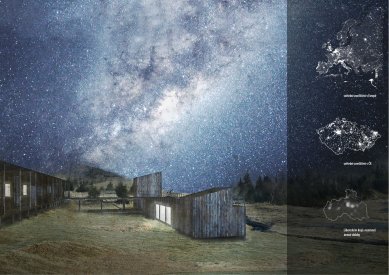
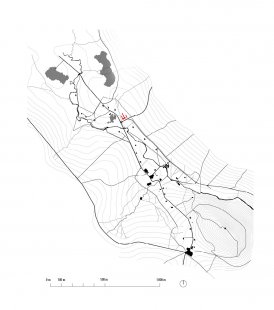
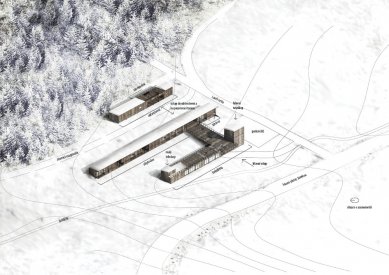
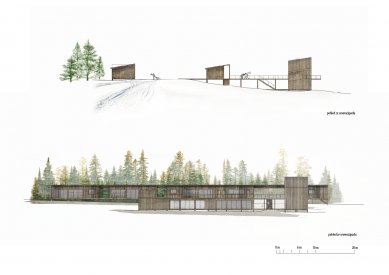
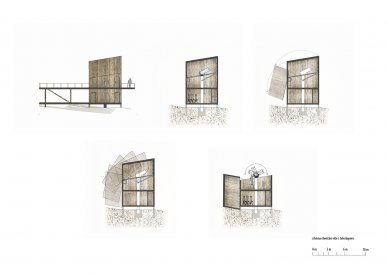
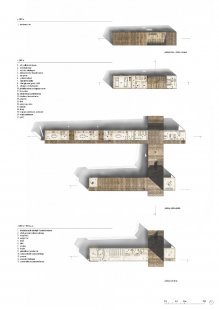
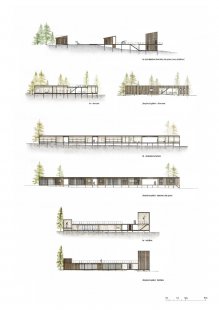
0 comments
add comment
Related articles
0
08.03.2016 | <!DOCTYPE html>
<html lang="en">
<head>
<meta charset="UTF-8">
<meta name="viewport" content="width=device-width, initial-scale=1.0">
<title>Ještěd in a Cage 15 - Winning Project</title>
</head>
<body>
<h1>Ještěd in a Cage 15 - Winning Project</h1>
</body>
</html>
0
08.03.2016 | Ještěd in the cage 15 - 2nd place
0
08.03.2016 | <!DOCTYPE html>
<html>
<head>
<title>Translation</title>
</head>
<body>
<p>Ještěd in the cage 15 - 3rd place</p>
</body>
</html>
0
08.03.2016 | Ještěd in the cage 15 - nomination Libor Šenekel
0
08.03.2016 | <Jezd f kleci 15 - nominace Cisarikova, Devyatkina, Valenta>
0
08.03.2016 | Ještěd in the cage 15 - nomination Martin Holba
0
08.03.2016 | Ještěd in the cage 15 - nomination Martin Málek
0
08.03.2016 | Ještěd in a Cage 15 - nomination Barbora Slavíčková
0
08.03.2016 | Ještěd in the cage 15 - nomination Kohoutková, Nekola, Šmejkalová
0
21.02.2016 | Ještěd in the cage 15 - festive announcement
0
03.02.2016 | <!DOCTYPE html>
<html lang="en">
<head>
<meta charset="UTF-8">
<meta name="viewport" content="width=device-width, initial-scale=1.0">
<title>Invitation to Announcement</title>
</head>
<body>
<h1>Ještěd in the Cage 15 - Invitation to the Announcement</h1>
</body>
</html>






